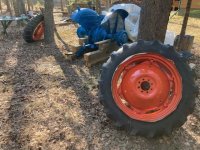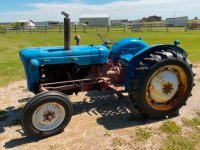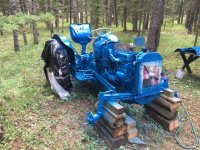I have a 1959 Fordson Dexta that I have been working on for the last couple years. I use it as acreage tractor doing light odd jobs. I has Ca in the rear tires. One tire has more than the other as it is considerably heavier. I experienced this when I took them off to paint. I am considering having the Ca removed and I have heard that I if I do this I should have the tubes replaced. The other choice is to have the lighter tire with Ca topped up and leave them as they are. I don't really see the need to have the Ca in the tires as not doing any real work with the unit but as I am a relative novice, wondering if this might be a mistake with the handling of the tractor with no ballast. As well, can I just drain the Ca Cl2 into a bucket, get as much out as I can then run it that way? Wondering what the experience says.
You are using an out of date browser. It may not display this or other websites correctly.
You should upgrade or use an alternative browser.
You should upgrade or use an alternative browser.
CaCL2 in Rear Tires
- Thread starter YYCBill
- Start date
- Views: 968
More options
Who Replied?
/ CaCL2 in Rear Tires
#1
Carl_NH
Elite Member
- Joined
- Apr 5, 2002
- Messages
- 3,910
- Location
- Coastal NH
- Tractor
- 01 Kubota B21TLB, 2010 Ferris 52" ZTR, Cub Cadet 1811, Gravely Super8
I did a similar project with a 1980's Kubota L185 which had calcium in the rims, but the rims were eaten thru around the valve stems and other areas. So I took the tires off the rims, had them sandblasted patched/welded and put new tubes and no calcium.
IF your rims aren't rusted through or leaking, I would leave "as is" with the ballast you have in them today - once you open the valve and add more or take any out, it may continue to leak. Plus you have primed them now and if no big holes in the rims - just run it until you need to replace the tires.
IF your rims aren't rusted through or leaking, I would leave "as is" with the ballast you have in them today - once you open the valve and add more or take any out, it may continue to leak. Plus you have primed them now and if no big holes in the rims - just run it until you need to replace the tires.
i7win7
Elite Member
When the tube starts leaking, the highly corrosive salt will rust out the rims. I would drain the fluid, remove the tires, clean tire & rim. Rim may need to be repainted before remounting tires with new tubes.

A good owner/operator would see the leaking calcium prior to the thing looking like it was living next to the titanic.
I have a tc40 with liquid leaking out of the cracks in the sidewalls. But I know it's not calcium and keep an eye on things. Il take the beet juice out and tube the tires some day.
I have a tc40 with liquid leaking out of the cracks in the sidewalls. But I know it's not calcium and keep an eye on things. Il take the beet juice out and tube the tires some day.
rScotty
Super Member
- Joined
- Apr 21, 2001
- Messages
- 9,658
- Location
- Rural mountains - Colorado
- Tractor
- Kubota M59, JD530, JD310SG. Restoring Yanmar YM165D
I've had a dozen tractors in the last 50 years and none of them had the tires filled. On two I did use cast iron wheel weights. There are some soils and some tradtional farming practices - like deep tillage in wet clay soil - where a farmer nees every bit of traction he can get. Loading the tires makes sense for that.
Somehow it has become standard practice to put fluid in the tires.
But now that I am doing mostly loader work instead of plowing, and for everything I use a tractor for it makes more to just use standard tires on standard rims. Flats or leaks are easy to deal with, the ride is better, the tire is easier on the land, and tire rims never corrode.
rScotty
Somehow it has become standard practice to put fluid in the tires.
But now that I am doing mostly loader work instead of plowing, and for everything I use a tractor for it makes more to just use standard tires on standard rims. Flats or leaks are easy to deal with, the ride is better, the tire is easier on the land, and tire rims never corrode.
rScotty
Thanks for the advice and experience. I talked to a tire shop and got the same advice. If they are not leaking, leave them alone until they need to be worked on. They advised that attempting to add or drain fluid could likely result in needing to do additional work. Their advice - don't touch them until you need to then be prepared for rim work and potentially some time up on blocks.I did a similar project with a 1980's Kubota L185 which had calcium in the rims, but the rims were eaten thru around the valve stems and other areas. So I took the tires off the rims, had them sandblasted patched/welded and put new tubes and no calcium.
IF your rims aren't rusted through or leaking, I would leave "as is" with the ballast you have in them today - once you open the valve and add more or take any out, it may continue to leak. Plus you have primed them now and if no big holes in the rims - just run it until you need to replace the tires.
Thanks again
I bought a 30yr old kubota b8200 that didnt have air filled tires. Idk how the person used the loader at all because the thing was nearly un useable with out significantly weight on the rear, and a land scape rake isnt going to cut it.I've had a dozen tractors in the last 50 years and none of them had the tires filled. On two I did use cast iron wheel weights. There are some soils and some tradtional farming practices - like deep tillage in wet clay soil - where a farmer nees every bit of traction he can get. Loading the tires makes sense for that.
Somehow it has become standard practice to put fluid in the tires.
But now that I am doing mostly loader work instead of plowing, and for everything I use a tractor for it makes more to just use standard tires on standard rims. Flats or leaks are easy to deal with, the ride is better, the tire is easier on the land, and tire rims never corrode.
rScotty
Weight typicaly means traction. If you dont need traction in poor conditions then you dont need weight.


